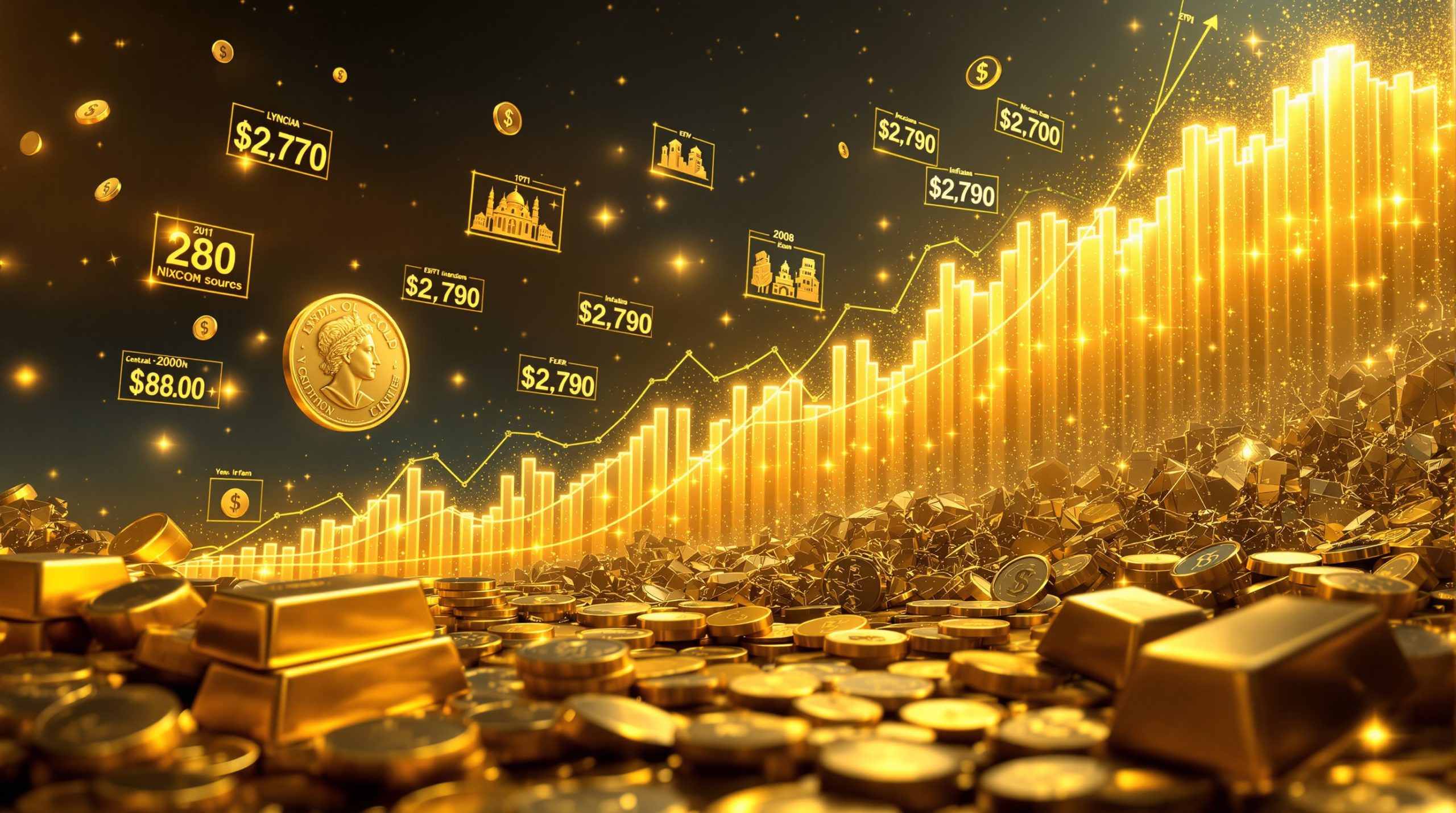Understanding the Current Gold Market Dynamics
Recent Price Movements and Market Significance
The gold market has experienced unprecedented momentum recently, with prices surging by approximately $100 in a single weekend. This remarkable rally has propelled gold to record highs, demonstrating the extraordinary strength of the current precious metals bull market. Industry experts are particularly intrigued by this movement, as it appears to signal a fundamental shift in market dynamics.
The current gold market valuation stands at approximately $22 trillion, making it one of the most substantial asset classes globally. What's particularly noteworthy is that despite rising prices, physical gold is becoming increasingly difficult to acquire. This scarcity phenomenon contradicts traditional economic models where higher prices typically stimulate increased supply.
Kilo bars, a standard unit for institutional investors, now command approximately $110,000-$115,000 each. This pricing reflects not just the spot price but also the growing premiums paid for physical delivery, indicating strong demand fundamentals in the gold and silver market trends.
What's Driving Gold's Unprecedented Rally?
According to market analysts, we're witnessing the collapse of the "virtuous circle" economic model that previously controlled markets. This model relied on coordinated central bank policies to maintain asset price stability across various sectors. As this system breaks down, gold's role as a hedge has regained prominence.
A significant factor in gold's recent performance is the reduced price management in futures markets compared to previous years. Historically, gold prices were heavily influenced by paper trading activity, with daily futures volumes sometimes representing half a year's worth of actual gold production. This manipulation capacity has diminished considerably in recent months.
Institutional and central bank demand has surged, with many entities now demanding physical delivery rather than settling contracts in cash. This fundamental shift exerts upward pressure on prices as physical gold needs to be located and delivered, unlike paper contracts that can be created with minimal backing.
The significant reduction in futures market volume manipulation represents a regime change in how gold is priced. Without artificial price suppression mechanisms, the metal is finding its natural value based on actual supply and demand fundamentals.
The Futures Market Influence on Gold Prices
Historical evidence points to systematic price management through futures markets over the past several decades. The primary mechanism involved flooding markets with paper contracts during periods of rising prices, effectively dampening upward momentum without requiring actual metal.
Previous trading patterns were remarkable in their scale – half a year's worth of global gold production would sometimes trade in a single day, a volume impossible to explain through legitimate hedging or investment activity. These enormous paper volumes served to disconnect prices from physical market realities.
Current market conditions show clear signs of unwinding this price suppression. As institutional investors increasingly demand physical delivery, the disconnect between paper and physical markets becomes unsustainable. The resulting squeeze forces prices higher as actual metal must be found to satisfy delivery requirements.
Market experts anticipate potential price overshooting before finding equilibrium as decades of artificial price constraints are removed. This adjustment process could lead to periods of extreme volatility before a new equilibrium reflecting true supply and demand is established.
Silver Market Analysis: The Forgotten Precious Metal
Why Is Silver Lagging Behind Gold?
The current gold-to-silver ratio stands at approximately 104.82:1, representing an historically extreme level. For perspective, the geological occurrence ratio of silver to gold in the Earth's crust is approximately 17:1, while the historical trading ratio has averaged between 40:1 and 60:1 for much of recorded history.
Silver prices have proven easier to control through futures markets due to the smaller contract sizes and lower overall market capitalization. This makes the silver market more vulnerable to concentrated trading activity designed to influence prices, particularly during low-liquidity periods.
Industrial demand consumes a significant portion of annual silver production, creating a fundamental difference with gold. While gold is primarily held for investment and monetary purposes, silver serves dual roles as both an industrial commodity and monetary metal, complicating its price dynamics.
The silver market has experienced limited sovereign interest compared to gold markets. While central banks actively accumulate gold reserves, there is minimal central bank participation in silver markets, removing a significant source of stable demand that supports gold prices.
Silver's Storage Challenges vs. Investment Potential
Physical silver requires substantially more storage space than equivalent gold value – approximately 100 times more volume for the same dollar amount. This practical constraint makes large silver positions logistically challenging for institutional investors and high-net-worth individuals.
Annual silver production globally is estimated around 900 million ounces, with much of this output being consumed by industrial applications rather than flowing into investment channels. This creates a potentially explosive supply-demand dynamic if investment demand increases significantly.
The industrial consumption of silver creates a steady baseline demand that supports price floors but can also limit availability for investment purposes. Key industries including electronics, solar panel manufacturing, and medical applications rely on silver's unique properties and have few viable substitutes.
Market analysts suggest potential for dramatic price movement if physical delivery demands increase, particularly given the relatively small size of the investment-grade silver market. Even modest shifts in allocation preferences could overwhelm available supplies of investment-grade silver products.
The COVID Impact on Silver Markets
The silver market experienced near-crisis conditions during COVID when investors attempted to take physical delivery en masse. Major dealers ran out of inventory, and premiums on retail silver products soared to unprecedented levels, sometimes exceeding 100% of the spot price.
Futures market rules were overwhelmed by physical demand, leading to situations where spot prices remained depressed while physical products commanded enormous premiums. This disconnect highlighted the potential vulnerability of paper pricing mechanisms when confronted with determined physical buying.
Industry observers note that a similar scenario appears increasingly possible in the current environment, particularly if institutional investors begin demanding physical silver in significant quantities. The relative thinness of the physical silver market compared to gold makes it vulnerable to supply squeezes.
How to Position Your Portfolio in the Current Precious Metals Environment
Gold vs. Silver Investment Considerations
Gold currently shows stronger momentum and institutional interest, benefiting from central bank purchases and wealth preservation flows from high-net-worth individuals. This established demand base provides stronger support for current price levels and potential future appreciation.
Silver potentially offers higher percentage gains if the gold-to-silver ratio normalizes toward historical averages. A reversion to even a 60:1 ratio would imply silver prices significantly higher than current levels, assuming gold maintains its value.
Storage considerations favor gold for larger allocations, particularly for investors with space constraints or security concerns. The 100:1 volume difference between equal values of gold and silver makes the former much more practical for substantial holdings in limited space.
Physical delivery is becoming an increasingly important factor in precious metals investment strategy. Investors who previously accepted paper proxies for metals exposure are increasingly demanding actual metal, reflecting growing concerns about counterparty risk in financial markets.
Physical Ownership vs. Paper Investments
Market trends show growing importance of actual physical metal possession rather than paper claims. This shift reflects diminishing trust in financial intermediaries and concerns about the potential for paper markets to accurately reflect physical metal values during crisis periods.
Premium increases on physical products have become notable across the precious metals market, with coins and small bars commanding 8-12% over spot prices for gold and often 20% or more for silver. These premiums reflect the real-world cost of converting paper prices to physical metal.
Availability constraints are becoming more prevalent, with dealers reporting extended delivery times and limited inventory of popular investment products. These supply chain pressures suggest potential further price pressures as demand outstrips the physical market's ability to deliver product.
Investors must carefully consider storage solutions and security considerations when building physical metal positions. Options range from personal safes and home storage systems to professional vault facilities with varying costs and security features.
Expert Predictions for Precious Metals Markets
Where Gold Prices Could Be Heading
Industry analysts suggest potential for prices to overshoot fair value before any correction occurs. This pattern is common in markets emerging from periods of price suppression, as price discovery mechanisms recalibrate to genuine supply and demand conditions.
Previous price levels around $2,000, which represented all-time highs just a few years ago, are now viewed as significantly undervalued given current monetary conditions and inflation data. This perspective highlights how rapidly fundamental valuations have shifted.
Central bank and sovereign wealth fund positioning continues to favor gold accumulation, with many nations actively diversifying reserves away from traditional currency holdings. This structural demand provides a stable floor for prices even during corrective phases.
De-financialization trends support higher gold valuations as investors and institutions seek assets outside traditional financial markets. This movement reflects growing concerns about systemic risk and counterparty exposure in an increasingly leveraged global financial system.
The Silver Price Outlook
Market experts anticipate potential for ratio compression from current 105:1 levels toward more historically normal ranges. Even a partial normalization to 70:1 would represent significant percentage gains for silver relative to gold.
Industrial demand impact on available investment supply remains a critical factor for silver markets. Technological developments, particularly in renewable energy and electronics, continue to consume significant portions of annual production, potentially limiting supplies available for investment.
Analysts note challenges in predicting timing of market awakening to silver's relative undervaluation. While the fundamental case appears strong, silver has historically experienced extended periods of underperformance before explosive moves to the upside.
Storage considerations remain important for substantial positions, with investors needing to balance the higher potential returns of silver against the practical logistics of securing and storing much larger volumes compared to equivalent gold investments.
FAQ: Common Questions About Gold and Silver Investing
What's causing the current surge in gold prices?
The current gold price surge appears to be driven by reduced price management in futures markets, increased physical delivery demands, and a shift away from the "virtuous circle" economic model that previously controlled markets. Central banks have shifted from sellers to buyers of gold, creating consistent demand for physical metal. Additionally, comprehensive gold market analysis shows growing concerns about currency debasement and inflation have increased gold's appeal as a monetary asset outside the banking system.
Why is the gold-to-silver ratio so extreme right now?
The gold-to-silver ratio of approximately 105:1 reflects silver's easier price control through futures markets, significant industrial consumption, and limited sovereign interest compared to gold. Silver's dual role as both industrial commodity and monetary metal creates more complex price dynamics than gold, which functions primarily as a monetary and investment asset. Historical patterns suggest this extreme ratio may not be sustainable long-term, potentially offering opportunities for investors willing to accept silver's higher volatility and storage requirements.
Is physical precious metal ownership better than ETFs or mining stocks?
Physical ownership provides direct exposure without counterparty risk, though it requires secure storage solutions. The current market environment shows increasing premiums and availability constraints for physical metals. Gold ETFs strategies offer convenience but introduce third-party risk and governance questions about actual metal backing. Mining stocks provide operational leverage to metal prices but add company-specific risks and market correlation not present in physical metals. The optimal approach depends on individual investment goals, security concerns, and liquidity requirements.
What storage solutions are recommended for silver given its bulk?
Professional storage facilities, private vaults, or strategic home storage systems are recommended for silver due to its significant space requirements compared to gold of equivalent value. Institutional investors typically use specialized vaulting services with insurance coverage, while retail investors might consider a combination of home safes for smaller amounts and third-party storage for larger holdings. The cost-benefit analysis must consider storage fees against the potential for higher returns from silver compared to gold during bull markets in precious metals.
Remember that gold and silver market trends can change rapidly based on macroeconomic conditions, central bank policies, and shifts in investment sentiment. The gold market outlook suggests diversification across both metals may provide optimal exposure to the precious metals sector while balancing their distinct characteristics and performance patterns. Furthermore, understanding broader global commodities insights can provide context for how these metals fit within the overall resources landscape.
Looking for the Next Major Gold or Silver Discovery?
Gain immediate notifications on significant ASX mineral discoveries with Discovery Alert's proprietary Discovery IQ model, turning complex gold and silver market data into actionable investment opportunities. Explore why major discoveries can lead to exceptional returns by visiting Discovery Alert's dedicated discoveries page and start your 30-day free trial today to position yourself ahead of the market.




